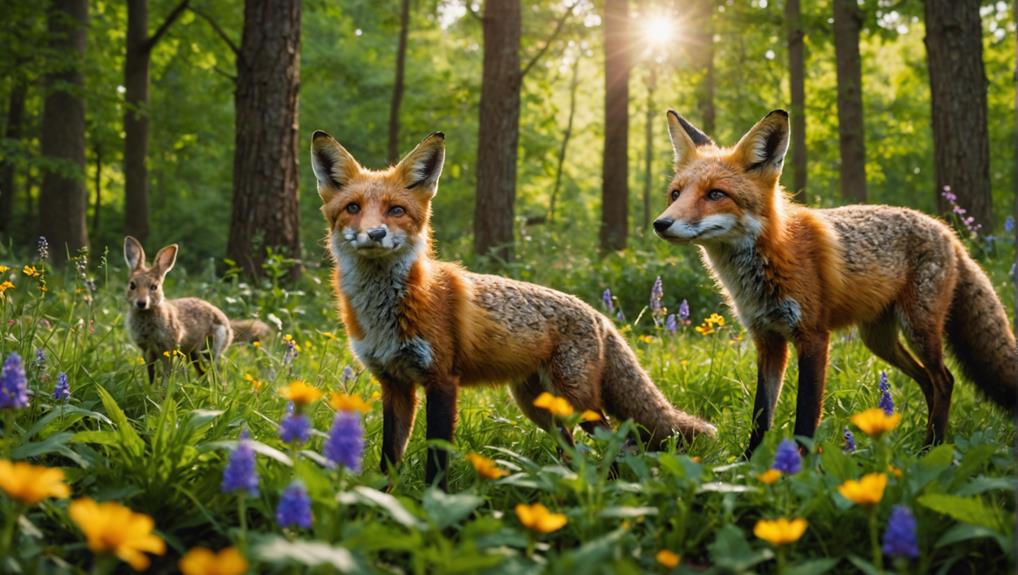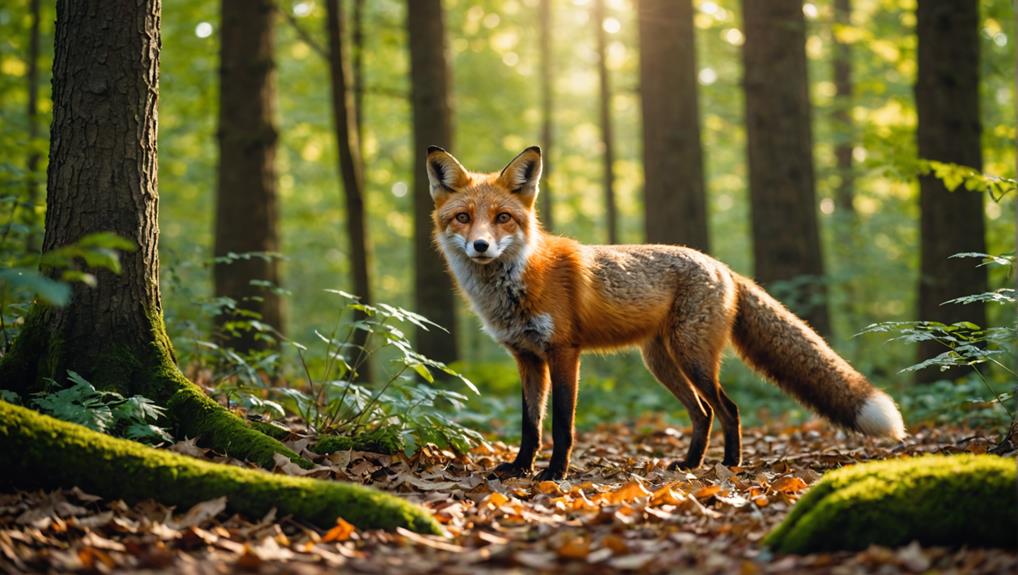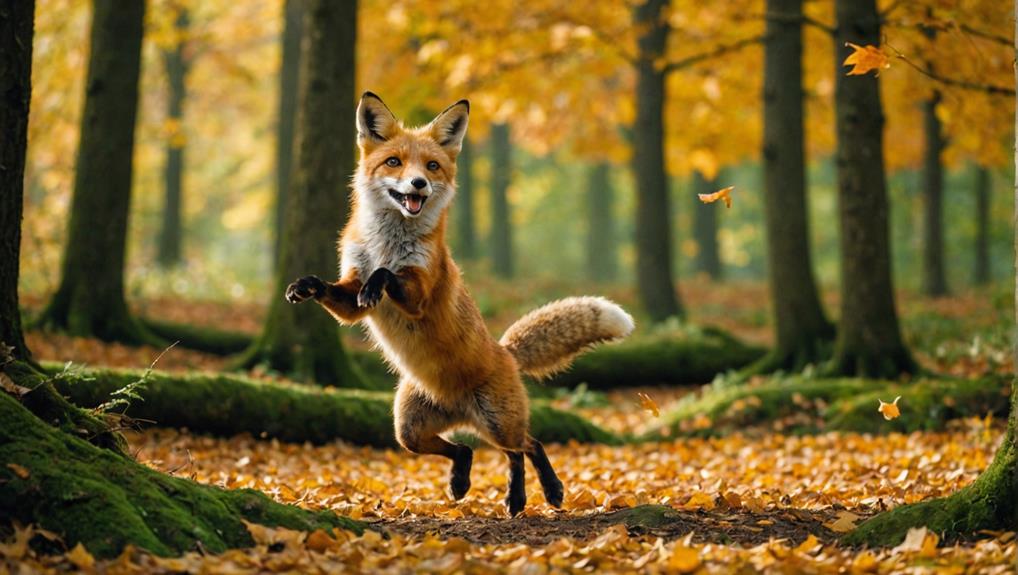Playful fox temperament is all about energy and social fun! These clever critters engage in lively antics, like chasing and mock fighting, which not only showcases their playful spirit but also helps them bond with each other. Imagine a bunch of foxes frolicking together, honing their skills while having a blast—that's play at its finest! This playful behavior isn't just for giggles; it's essential for their social skills and emotional health. Play also helps them practice their hunting techniques while forging strong connections within their family groups. Stick around, and you'll discover even more fascinating fox facts!
Contents
- 1 Characteristics of Playful Foxes
- 2 Importance of Play in Development
- 3 Social Interactions and Bonding
- 4 Playful Behavior in Different Environments
- 5 Emotional Complexity of Foxes
- 6 Hunting Skills and Play
- 7 Communication Through Play
- 8 Human-Fox Interactions
- 9 Adaptability and Urban Living
- 10 Conservation of Playful Foxes
- 11 Final Thoughts
Characteristics of Playful Foxes
When you observe playful foxes, you'll notice they thrive on social interactions, engaging in activities like chasing, play fighting, and jumping. These lively antics are especially evident among fox cubs, who seem to have an endless supply of energy. Just picture those little furballs tumbling over each other or bounding around like they've got springs in their paws!
Their playful nature isn't just for kicks; it's fundamental for developing social skills and strengthening bonds. You might even catch adult foxes joining in on the fun, playfully nipping at each other during courtship rituals. It's like a dance that enhances their connections within family groups.
What's more, playful foxes don't limit their antics to their own kind. They've been known to engage in humorous behaviors with larger animals too, showcasing their adventurous and curious spirits. Whether they're bouncing on a trampoline or rolling in the grass, their playfulness highlights their emotional complexity.
Importance of Play in Development
Play serves a significant role in the development of foxes, particularly for cubs as they navigate their formative years. You might be surprised to learn just how important play behavior is for these little furballs. It's not just about having fun—even though they sure love that!
Here are four key reasons why play is essential:
- Social Development: Through play, cubs learn how to establish hierarchies and interact with others, which helps them understand their place in the world.
- Skill Refinement: Play fighting hones their coordination, agility, and hunting techniques, preparing them for survival as they grow up.
- Emotional Complexity: Engaging in playful antics allows foxes to express joy and manage stress, giving them a healthy emotional outlet.
- Conflict Resolution: Observing play provides young foxes with a chance to practice behaviors important for handling territory disputes and conflicts, setting them up for adult challenges.
Social Interactions and Bonding

Foxes thrive on social interactions that foster strong bonds within their groups. These playful behaviors aren't just for fun; they play a significant role in building relationships among foxes. For instance, adult foxes often engage in playful antics during courtship, which helps reinforce emotional connections between pairs.
Meanwhile, the cubs are busy learning essential social skills through play fighting, helping them figure out their place in the family hierarchy. This playful engagement is particularly important for species like the red fox, which adapt their behaviors to thrive in various environments.
You'll notice that interactions among foxes often include chasing and mock fighting. These playful behaviors are essential for strengthening group relationships and easing tensions.
Plus, grooming is another important aspect of these interactions. When foxes groom each other during play, they solidify their social bonds. If grooming's lacking, it could lead to isolation and even a group falling apart!
What's fascinating is how their thrill-seeking nature in play reveals the emotional complexity of foxes. They form strong social ties within their family units, making every playful moment count.
Playful Behavior in Different Environments
In various environments, a fox's playful behavior showcases its remarkable adaptability and resourcefulness. Whether they're in the wild or maneuvering urban landscapes, these clever creatures find ways to express joy and engage with their surroundings. You might even catch a fox jumping on a trampoline, looking like it's auditioning for a circus act!
Urban foxes, for instance, thrive in cities due to their flexible diets and ability to scavenge, which illustrates their adaptability in human-dominated environments.
Here are some fun examples of playful behavior you might observe:
- Cubs in the Wild: Young foxes engage in mock fights, honing their social skills and establishing hierarchies in a playful manner.
- Courtship Fun: Adult foxes use play during courtship, strengthening bonds with potential mates through light-hearted interactions.
- Urban Antics: In cities, foxes often chase after objects or playfully explore human-created environments, showing their cleverness.
- Family Playtime: Play is essential for emotional expression among family members, providing joy and fostering connections.
No matter the setting, playful behavior is a key part of what makes foxes so fascinating. Their ability to adapt and thrive while having fun is truly a reflection of their playful spirit!
Emotional Complexity of Foxes

Many observers are surprised to learn just how emotionally complex these animals can be. When you watch foxes play, it's clear their playful behaviors aren't just for fun. They engage in play fighting, which helps them form social hierarchies and develop essential skills.
Even adult foxes get in on the action during courtship rituals, showing that play is key for bonding and emotional expression. Curiously, species like the Kit Fox exhibit particularly playful demeanors, which further highlights their social nature.
You might find it amusing how thrill-seeking these little creatures can be. They bounce around on trampolines or frolic with bigger animals, revealing their joy and love for exploration. For young foxes, these playful interactions are vital for emotional growth. It's like their version of school, helping them learn how to navigate social structures within their groups.
Research emphasizes that the emotional life of foxes goes beyond mere survival. Play is woven into their daily lives, shaping their social dynamics.
Hunting Skills and Play
Hunting Skills and Play
Three key elements define the relationship between hunting skills and play in foxes: stealth, agility, and social interaction.
When you watch foxes at play, you might notice how their antics aren't just for fun; they're sharpening their hunting skills! Red foxes, known for their adaptability in diverse environments, demonstrate these skills through their playful behaviors, which can be observed in various habitats, including urban settings where they thrive.
The playful interactions among young cubs also reflect their ability to adapt and learn from their surroundings, showcasing their flexible feeding habits.
- Stealth: Young cubs practice stalking their siblings, sneaking up like little ninjas in the grass.
- Agility: Quick pounces during play fighting mirror the moves they'll use in real hunts later on.
- Chasing: Adult foxes engage in playful chases that help them reinforce their reflexes, which are essential for catching prey.
- Wrestling: This playful behavior not only entertains but also hones their coordination needed for successful hunting.
As playful foxes dart around, they're simulating hunting strategies, turning their fun into a serious skill-building exercise.
It's like a game of tag, but with an important twist—every leap and bound is a chance to practice catching their dinner.
Communication Through Play

Playful interactions among foxes go beyond just honing hunting skills; they're essential for communication within their social structures.
When you watch cubs play fighting, you'll see them tumbling and rolling around. This isn't just fun; it's how they learn to communicate with each other and understand their place in the family hierarchy.
Those playful yelps and barks? They express excitement and joy, making it clear that everyone's ready to have a good time.
You might notice their body language too. With wagging tails and erect ears, they signal friendliness and non-aggression. It's like they're saying, "Hey, I'm just here to have fun!"
These playful interactions also help the young ones practice hunting techniques without any real pressure. They can develop those important survival skills while still keeping it light-hearted.
Human-Fox Interactions
When you watch foxes in their natural habitat, you're not just seeing cute animals; you're getting a glimpse into their playful world.
By understanding their behavior, you can enjoy these encounters while keeping a respectful distance, which helps promote a peaceful coexistence.
Observing Fox Behavior
Observing a fox's behavior in its natural habitat can be an enchanting experience, especially as you witness their playful interactions.
These clever creatures showcase a variety of playful behaviors that are fascinating to watch. Here are some highlights you might enjoy:
- Wrestling Matches: Watch as cubs engage in friendly wrestling, honing their social skills while establishing a hierarchy.
- Chasing Games: Adult foxes often join in the fun, proving that playfulness isn't just for the young.
- Ritualized Play Fighting: Their play fighting includes careful moves to avoid injury, showing a deep understanding of social dynamics.
- Urban Encounters: In cities, you might spot foxes frolicking in parks, making it easier to observe their charming antics.
As you enjoy these moments, remember that keeping a respectful distance is key.
Not only does it help you appreciate their playful nature, but it also minimizes the chances of conflict.
Watching foxes in action can bring a smile to your face, revealing just how delightful and complex their behaviors truly are.
Promoting Positive Coexistence
Promoting positive coexistence between humans and foxes hinges on understanding their behavior and communication. Foxes are fascinating creatures, and learning how they express themselves can make your interactions much smoother.
For instance, by observing their body language and vocalizations, you'll gain insight into their feelings. It's best to watch these sly animals from a distance, as this respects their space and keeps you both safe. After all, you wouldn't want a fox to think you're trying to invade their territory!
Feeding wild foxes might seem like a friendly gesture, but it can lead to trouble down the road. When you feed them, they get too comfortable, which could spark unwanted encounters.
Instead, focus on educating your community about the natural behaviors and social structures of foxes. This knowledge fosters appreciation and respect for these adorable animals.
Additionally, supporting local habitat preservation efforts can help guarantee fox populations thrive alongside us.
Adaptability and Urban Living

The adaptability of red foxes in urban environments highlights their remarkable ability to thrive amidst human activity. These clever creatures showcase their playful temperament in ways that are both entertaining and surprising. You might find them playing on trampolines or chasing each other in a park, proving they can have fun while maneuvering through city life.
Here are some fascinating ways red foxes adapt to urban living:
- Resourcefulness: They cleverly exploit new food sources, from small mammals to tasty human leftovers.
- Social Structures: Urban living encourages foxes to form small family groups, enhancing their social interactions.
- Activity Timing: Being nocturnal, they adjust their playful and hunting behaviors to avoid busy human hours, staying one step ahead.
- Clever Navigation: Their emotional intelligence helps them navigate complex human landscapes, leading to more encounters with people.
Red foxes remind us that adaptability is key to survival. Whether they're sneaking a snack or frolicking in the moonlight, they're a delightful reminder of nature's resilience.
Conservation of Playful Foxes
Conserving playful foxes is crucial for their social development and overall health. Their playful behavior isn't just cute; it's a fundamental part of how they communicate and bond with each other. When you support conservation efforts, you're helping maintain healthy fox populations.
Creating wildlife sanctuaries allows these clever critters to engage in their natural play, which reduces stress and boosts their emotional well-being. It's like a furry spa day for them! Plus, education programs that spotlight the importance of playfulness can inspire community support for conservation initiatives.
Check out the table below to see how conservation efforts can benefit playful foxes:
| Conservation Action | Benefits to Playful Foxes | Community Impact |
|---|---|---|
| Establish wildlife sanctuaries | Reduces stress, promotes play behavior | Increases local engagement |
| Protect natural habitats | Guarantees space for playful activities | Preserves ecosystem balance |
| Conduct research | Informs better management strategies | Raises awareness of species needs |
| Implement education programs | Fosters understanding of fox dynamics | Encourages conservation support |
| Volunteer for cleanup | Cleans habitats for healthier play spaces | Builds community pride |
Final Thoughts
So, the next time you spot a playful fox, remember it's not just frolicking for fun. It's building bonds, sharpening skills, and showing its cleverness in a charming way. These little furballs remind us of the importance of play, whether in the wild or our backyards. Embracing their playful spirit can inspire us to find joy and connection in our own lives. After all, who doesn't need a little mischief now and then?














